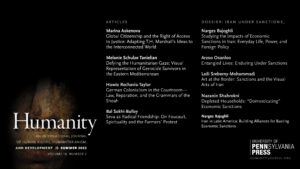Abstract: This essay interrogates Nicholas Kristof’s reporting on sex trafficking in Cambodia, examining the New York Times columnist’s narrative self-fashioning in the context of the neoimperialist rescue fantasies his writing perpetuates. It explores the intersections between Kristof’s writing and the various media he employs, and considers the effects of both on the audience he wishes to interpellate in the name of action. In his reporting, Kristof disseminates a set of truth claims about sex, work, and mobility; he presents himself as a global savior figure and encourages the “ironic” participation of his reader, who is moved less to take part in a cosmopolitan morality centered on justice for the Other than to identify with the savior and contemplate their own narcissistic performance of solidarity.
Current Issue

Our long-awaited issue of Humanity journal is out! Its special dossier, Iran under Sanctions, examines the myriad and devastating impacts of international sanctions on society, culture, and politics. The issue includes an essay on the legal case Herero and Nama v. The Federal Republic of Germany to theorize reparations for German colonialism and slavery as they became linked with the aftermath of the Shoah. It also includes essays on T.H. Marshall and the right of access to justice; visual representations of Armenian genocide survivors; and, the concept of radical friendship in relation to the Farmers’ Protests in India.
View entire issue > Save Save Save
📘'Choose Your Bearing: Édouard Glissant, Human Rights and Decolonial Ethics' is now available for pre-order!
❕Grab your copy and save 30% OFF using the code NEW30 at checkout : https://edin.ac/3JIcRne
@HumanityJ